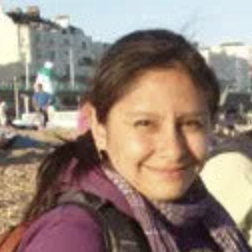
During her PhD, Amy Duchelle studied the management of Brazil nuts by communities in Peru, Brazil, and Bolivia; exploring stakeholder perceptions of the uses of Brazil nuts and timber. Courtesy of Janet Martinez Mendez
RIO DE JANEIRO, Brazil, (March 4, 2011) _ Amy Duchelle is a Research Fellow in the Forests and Livelihoods Programme at CIFOR’s Brazil office. Trained as a biologist and tropical forester, she has been on staff at CIFOR since 2010 to coordinate the Global Comparative Study on REDD (GCS C2) in Latin America. Through this study, Amy is trying to understand the effectiveness, efficiency and benefits of pilot REDD+ initiatives in the Amazon. Her key areas of expertise are community forest management, livelihoods, land use, land cover change, multiple-use forestry, and climate change mitigation through REDD+.
Why did you choose to work in the areas of community forest management and implementation of pilot REDD+ initiatives in the Amazon?
The tri-national region in Western Amazonia is particularly important because it is the global center of Brazil nut production (from the tree species Bertholletia excelsa) – an internationally important non-timber forest product that forms the base of local livelihoods. This formerly remote region is changing rapidly due to paving of the Interoceanic Highway through Peru, which will provide regional access to Pacific ports. In this dynamic context, there are valid concerns about conservation of Brazil nut-rich forests and the future of the communities that depend on these nuts for their livelihoods. On the Brazilian side of the border, the state government of Acre is launching a statewide REDD+ program, which is one of our GCS-REDD C2 research sites.
What do you find are the most challenging aspects of your work and how do you overcome them?
My research has always depended heavily on fieldwork and spending weeks, if not months, at a time living and working in forest-based communities. During fieldwork, I have met some incredible women, who have opened their homes and lives to me. As a woman traveling to many of these remote places on my own, or as the leader of field teams, these close relationships with local women have been extremely important to me. I usually try to stay with as many different families as possible during fieldwork, to get to know not just the outgoing women leaders in the communities, but also the women who may be a bit quieter or have less of an active role in local decision-making.
While the Brazil nut harvest is generally dominated by men, women do participate in the harvest, and I have met some important female leaders in the region who have articulated the need to conserve Brazil nut-rich forests and increase the value of nuts gleaned by local people.
What aspects do you enjoy most in your work with women?
I enjoy their enthusiasm, their willingness to participate in research activities, their desire for a better life for themselves and for their families, and their openness. In the GCS-REDD C2 work, we implement a Women’s Survey as a way to give women a voice in the research and obtain information specific to the experience, knowledge and livelihood activities of women. Two of our Field Research Supervisors – Marina Cromberg and Maria Fernanda Gebara – consistently reported the particular successes of these meetings and the positive reactions of local women, who were pleased to be actively included in the research process.
Can you tell us about a memorable experience you have had while doing research on community forest management?
During the first three months of my Ph.D. fieldwork focused on Brazil nut management in Western Amazonia, I traveled between communities in Brazil, Bolivia, and Peru to accompany Brazil nut harvests with the goal of understanding different production systems. My first collection trips were with two women in Bolivia, whose husbands did not participate in the harvest, so they would go out on their own. These women were tough as nails and they were the first people to teach me how to take care when picking up Brazil nut fruits to avoid being bitten by scorpions or snakes, how to pile the fruits far away from the canopies of the Brazil nut trees to avoid the risk of large fruits falling on us while we hacked open the hard shells with a machete, and how much strength it takes to carry a heavy load (more than 20kg) of Brazil nuts out of the forest.
As a woman, when you meet another woman whose livelihood is from the forest, what have you found to be the biggest constraints they face in participating in the management of their forests?
Women’s livelihood systems are incredibly diverse. They are not only involved in forest-based activities, growing crops and caring for livestock, but also care for their homes and children.In the Western Amazon, I observed women to be less dominant in cash-based forest activities, especially in timber management, but again there are always a handful of women who assume an active role in these activities.
What has been the most important lesson you have learned from their knowledge and traditions?
I don’t know if there is one lesson in particular, but more a sense of how resilient these women are, how they cope with constant change and insecure conditions, and devastating losses: such as the death of young children due to poor health conditions.
We want you to share Forests News content, which is licensed under Creative Commons Attribution-NonCommercial-ShareAlike 4.0 International (CC BY-NC-SA 4.0). This means you are free to redistribute our material for non-commercial purposes. All we ask is that you give Forests News appropriate credit and link to the original Forests News content, indicate if changes were made, and distribute your contributions under the same Creative Commons license. You must notify Forests News if you repost, reprint or reuse our materials by contacting forestsnews@cifor-icraf.org.



